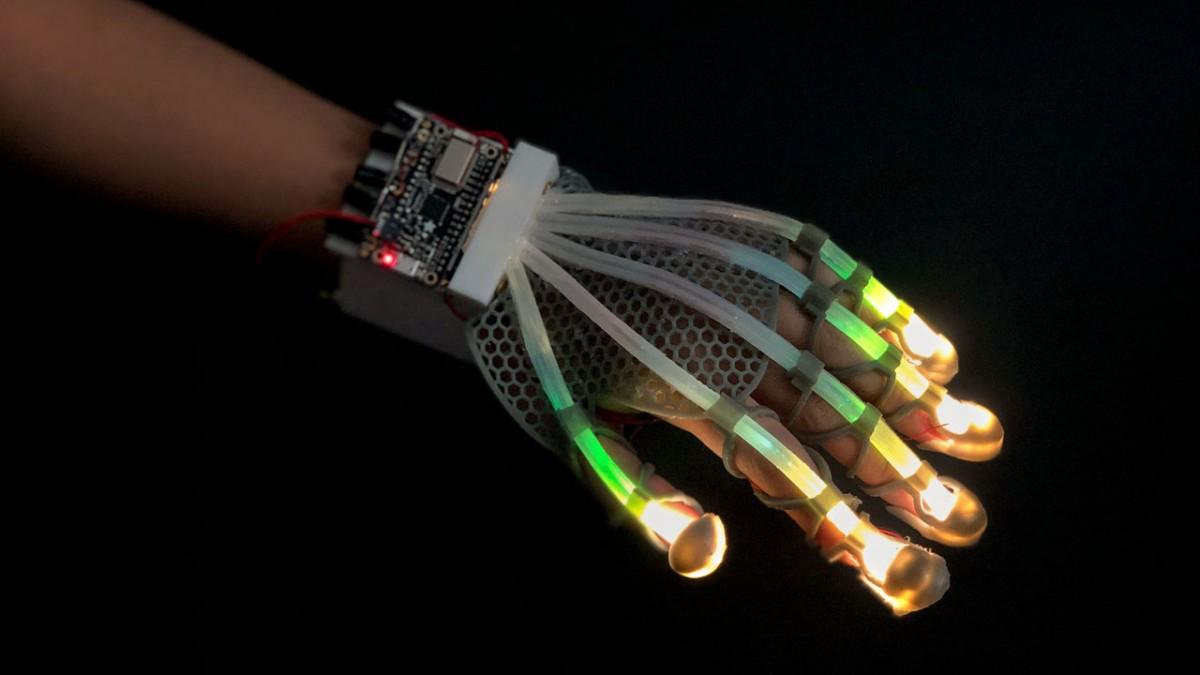R.E.News future Technology-The Future of Self-Powered Tactile Sensors for Robotics and Wearables
 07/01/25-FR-English-NL-footer
07/01/25-FR-English-NL-footer
L’avenir des capteurs tactiles autonomes pour la robotique et les objets connectés
 Image- Researchers from Chung-Ang University in South Korea
Image- Researchers from Chung-Ang University in South Korea
Dans le monde en évolution rapide de la robotique et des technologies portables, les capteurs tactiles ouvrent la voie à l’innovation. Des chercheurs de l’université Chung-Ang en Corée du Sud, dirigés par le professeur Hanjun Ryu, ont fait un pas de géant dans ce domaine.
Ils ont développé des stratégies de fabrication de pointe pour améliorer les performances des capteurs piézoélectriques et triboélectriques, dans le but de relever des défis tels que la fragilité et la résilience environnementale. Cette avancée, publiée dans l’International Journal of Extreme Manufacturing, devrait redéfinir la technologie des capteurs pour les applications de nouvelle génération.
Mais pourquoi les capteurs tactiles sont-ils si cruciaux ? Ces appareils autonomes convertissent les stimuli mécaniques en signaux électriques, ce qui les rend essentiels pour la robotique, les soins de santé et les interfaces homme-machine. Plongeons au cœur de cette innovation fascinante.
Qu’est-ce qui fait fonctionner les capteurs tactiles ?
Les capteurs tactiles fonctionnent selon deux mécanismes principaux :
Capteurs piézoélectriques : ils génèrent une tension lorsqu'une contrainte mécanique est appliquée à des matériaux spécifiques, tels que le quartz ou le PVDF (polyfluorure de vinylidène). Ils sont appréciés pour leur sensibilité, mais ils sont confrontés à la fragilité des matériaux.
Capteurs triboélectriques : fonctionnant sur transfert de charge induit par contact, ces capteurs offrent une efficacité élevée et des capacités d'auto-alimentation, mais sont souvent confrontés à des défis environnementaux.
Bien que les deux types de capteurs présentent des atouts uniques, ils présentent également leurs propres limites. L'équipe de recherche de l'université de Chung-Ang s'est efforcée de surmonter ces obstacles, en combinant la science des matériaux et des techniques de fabrication avancées pour créer une solution globale.
Pour s'attaquer à la fragilité inhérente des matériaux piézoélectriques, les chercheurs ont utilisé des méthodes innovantes telles que :
Dopage et contrôle de la cristallinité : amélioration de la constante piézoélectrique pour une plus grande sensibilité.
Intégration de matériaux composites : fusion de céramiques sans plomb avec des polymères pour produire des capteurs flexibles et respectueux de l'environnement.
Impression 3D et cristallisation à base de solvants : ces techniques émergentes ont considérablement amélioré l'adaptabilité et les performances dynamiques.
Ces avancées ne s'attaquent pas seulement à la rigidité des capteurs piézoélectriques traditionnels, mais ouvrent également des possibilités pour leur utilisation dans les appareils portables et la robotique où la flexibilité est essentielle.
Les capteurs triboélectriques, d'autre part, ont été révolutionnés par les techniques de modification de surface :
Traitements au plasma et microstructuration : amélioration de l'interaction de surface pour stimuler le transfert de charge.
Optimisation de la constante diélectrique : amélioration de l'efficacité du capteur dans la génération de charge.
Matériaux hybrides et nanostructures : combinaison du meilleur des deux mondes : durabilité et flexibilité.
Ces stratégies garantissent que les capteurs triboélectriques peuvent résister aux environnements difficiles tout en conservant leurs performances de haut rendement.
L'un des aspects marquants de cette recherche est son approche interdisciplinaire. En combinant les atouts des capteurs piézoélectriques et triboélectriques, l'équipe vise à créer des capteurs multimodaux capables de détecter divers stimuli en temps réel. Cette synergie améliore non seulement les performances des capteurs, mais élargit également leur champ d’application dans de nombreux secteurs, de la robotique avancée aux appareils médicaux.
Le professeur Ryu a fait remarquer : « Notre étude explique les matériaux et les stratégies de fabrication des capteurs tactiles utilisant des effets piézoélectriques et triboélectriques, ainsi que les types de reconnaissance sensorielle. »
Les chercheurs ne se sont pas arrêtés aux avancées matérielles. Ils ont également exploré l’intégration de l’intelligence artificielle (IA) pour traiter les données tactiles plus efficacement. Grâce à l’IA, les capteurs peuvent analyser des entrées telles que la texture et la pression, imitant ainsi les capacités sensorielles humaines. Cette fusion de l’IA et de la détection tactile promet de :
Permettre une interprétation plus précise des données.
Améliorer la détection multi-stimuli pour les applications avancées.
Améliorer la prise de décision en temps réel dans la robotique et les objets connectés.
Le professeur Ryu a résumé les implications plus larges en déclarant : « On s’attend à ce que les capteurs multisensoriels basés sur l’IA apportent des contributions innovantes à de telles avancées dans divers domaines. »
L’impact de cette recherche s’étend bien au-delà du monde universitaire. En relevant des défis majeurs en matière de propriétés des matériaux et de fabrication, ces innovations ouvrent la voie à des systèmes intelligents qui s'intègrent parfaitement dans la vie quotidienne.
De la surveillance des soins de santé aux interfaces robotiques, les applications potentielles sont stupéfiantes :
Soins de santé : dispositifs de surveillance avancés pour les soins aux patients.
Robotique : interaction homme-machine et dextérité améliorées.
Objets portables : appareils plus intelligents et plus intuitifs pour une utilisation quotidienne.
Ce travail révolutionnaire établit non seulement une nouvelle référence pour les capteurs tactiles, mais souligne également l'importance de la collaboration interdisciplinaire pour repousser les limites technologiques.
Les innovations de l'Université Chung-Ang signalent un moment de transformation pour les capteurs tactiles, en combinant la science des matériaux, les techniques de fabrication et l'IA pour créer des solutions aussi flexibles que puissantes.
Alors que les industries adoptent de plus en plus de systèmes intelligents, l'intégration de capteurs tactiles avancés jouera sans aucun doute un rôle central dans l'élaboration de l'avenir de la technologie.
NJC.© Info Researchers from Chung-Ang University in South Korea
-------------------------------------------------------------------------------------------------------------
 07/01/25-English
07/01/25-English
The Future of Self-Powered Tactile Sensors for Robotics and Wearables
 Image- Researchers from Chung-Ang University in South Korea
Image- Researchers from Chung-Ang University in South Korea
In the rapidly evolving world of robotics and wearable technologies, tactile sensors are carving a path toward innovation. Researchers from Chung-Ang University in South Korea, led by Professor Hanjun Ryu, have taken a giant leap forward in this field.
They’ve developed cutting-edge manufacturing strategies to enhance the performance of piezoelectric and triboelectric sensors, aiming to address challenges like brittleness and environmental resilience. This breakthrough, published in the International Journal of Extreme Manufacturing, is set to redefine sensor technology for next-generation applications.
But why are tactile sensors so crucial? These self-powered devices convert mechanical stimuli into electrical signals, making them essential for robotics, healthcare, and human-machine interfaces. Let’s delve into the heart of this fascinating innovation.
What Makes Tactile Sensors Tick?
Tactile sensors operate through two primary mechanisms:
Piezoelectric Sensors: These generate voltage when mechanical stress is applied to specific materials, such as quartz or PVDF (polyvinylidene fluoride). They are lauded for their sensitivity but struggle with material brittleness.
Triboelectric Sensors: Operating on contact-induced charge transfer, these sensors boast high efficiency and self-powered capabilities but often face environmental challenges.
While both types of sensors bring unique strengths to the table, they also come with their own set of limitations. The research team at Chung-Ang University set out to overcome these hurdles, combining material science and advanced fabrication techniques to create a holistic solution.
To tackle the inherent brittleness of piezoelectric materials, the researchers employed innovative methods such as:
Doping and Crystallinity Control: Enhancing the piezoelectric constant for greater sensitivity.
Composite Material Integration: Merging lead-free ceramics with polymers to produce flexible, eco-friendly sensors.
3D Printing and Solvent-Based Crystallisation: These emerging techniques have significantly improved adaptability and dynamic performance.
These advancements not only address the rigidity of traditional piezoelectric sensors but also open up possibilities for their use in wearable devices and robotics where flexibility is key.
Triboelectric sensors, on the other hand, were revolutionised through surface modification techniques:
Plasma Treatments and Microstructuring: Enhancing surface interaction to boost charge transfer.
Dielectric Constant Optimisation: Improving the sensor’s efficiency in charge generation.
Hybrid Materials and Nanostructures: Combining the best of both worlds—durability and flexibility.
These strategies ensure that triboelectric sensors can withstand harsh environments while maintaining their high-output performance.
One of the standout aspects of this research is its interdisciplinary approach. By combining the strengths of piezoelectric and triboelectric sensors, the team aims to create multi-modal sensors capable of detecting various stimuli in real time. This synergy not only enhances sensor performance but also expands their application scope across industries—from advanced robotics to medical devices.
Prof. Ryu remarked, “Our study explains the materials and device fabrication strategies for tactile sensors using piezoelectric and triboelectric effects, as well as the types of sensory recognition.”
The researchers didn’t stop at hardware advancements. They also explored the integration of artificial intelligence (AI) to process tactile data more effectively. With AI, sensors can analyse inputs like texture and pressure, mimicking human sensory capabilities. This fusion of AI and tactile sensing promises to:
Enable more accurate data interpretation.
Improve multi-stimuli detection for advanced applications.
Enhance real-time decision-making in robotics and wearables.
Prof. Ryu summarised the broader implications, stating, “It is anticipated that AI-based multi-sensory sensors will make innovative contributions to such advancements in various fields.”
The impact of this research extends far beyond academia. By addressing key challenges in material properties and fabrication, these innovations pave the way for intelligent systems that integrate seamlessly into daily life.
From healthcare monitoring to robotic interfaces, the potential applications are staggering:
Healthcare: Advanced monitoring devices for patient care.
Robotics: Enhanced human-machine interaction and dexterity.
Wearables: Smarter, more intuitive devices for everyday use.
This ground-breaking work not only sets a new benchmark for tactile sensors but also underscores the importance of interdisciplinary collaboration in pushing technological boundaries.
The innovations from Chung-Ang University signal a transformative moment for tactile sensors, blending material science, fabrication techniques, and AI to create solutions that are as flexible as they are powerful.
As industries increasingly embrace intelligent systems, the integration of advanced tactile sensors will undoubtedly play a pivotal role in shaping the future of technology.
NJC.© Info Researchers from Chung-Ang University in South Korea
----------------------------------------------------------------------------------------------------------------------
 07/01/25-NL
07/01/25-NL
De toekomst van zelfvoorzienende tactiele sensoren voor robotica en wearables
 Image- Researchers from Chung-Ang University in South Korea
Image- Researchers from Chung-Ang University in South Korea
In de snel evoluerende wereld van robotica en wearables technologieën banen tactiele sensoren een weg naar innovatie. Onderzoekers van de Chung-Ang Universiteit in Zuid-Korea, onder leiding van professor Hanjun Ryu, hebben een enorme sprong voorwaarts gemaakt op dit gebied.
Ze hebben geavanceerde productiestrategieën ontwikkeld om de prestaties van piëzo-elektrische en tribo-elektrische sensoren te verbeteren, met als doel uitdagingen zoals broosheid en milieubestendigheid aan te pakken. Deze doorbraak, gepubliceerd in het International Journal of Extreme Manufacturing, zal de sensortechnologie opnieuw definiëren voor toepassingen van de volgende generatie.
Maar waarom zijn tactiele sensoren zo cruciaal? Deze zelfvoorzienende apparaten zetten mechanische stimuli om in elektrische signalen, waardoor ze essentieel zijn voor robotica, gezondheidszorg en mens-machine-interfaces. Laten we dieper ingaan op de kern van deze fascinerende innovatie.
Wat drijft tactiele sensoren?
Tactile sensoren werken via twee primaire mechanismen:
Piëzo-elektrische sensoren: deze genereren spanning wanneer mechanische spanning wordt toegepast op specifieke materialen, zoals kwarts of PVDF (polyvinylideenfluoride). Ze worden geprezen om hun gevoeligheid, maar hebben moeite met broosheid van het materiaal.
Tribo-elektrische sensoren: deze sensoren werken op contactgeïnduceerde ladingsoverdracht en hebben een hoge efficiëntie en zelfvoorzienende mogelijkheden, maar worden vaak geconfronteerd met uitdagingen op het gebied van het milieu.
Hoewel beide soorten sensoren unieke sterke punten hebben, hebben ze ook hun eigen beperkingen. Het onderzoeksteam van de Chung-Ang University wilde deze obstakels overwinnen door materiaalkunde en geavanceerde fabricagetechnieken te combineren om een holistische oplossing te creëren.
Om de inherente broosheid van piëzo-elektrische materialen aan te pakken, gebruikten de onderzoekers innovatieve methoden zoals:
Doping en kristalliniteitscontrole: de piëzo-elektrische constante verbeteren voor een grotere gevoeligheid.
Integratie van composietmaterialen: loodvrije keramiek samenvoegen met polymeren om flexibele, milieuvriendelijke sensoren te produceren.
3D-printen en oplosmiddelgebaseerde kristallisatie: deze opkomende technieken hebben de aanpasbaarheid en dynamische prestaties aanzienlijk verbeterd.
Deze ontwikkelingen pakken niet alleen de stijfheid van traditionele piëzo-elektrische sensoren aan, maar openen ook mogelijkheden voor hun gebruik in draagbare apparaten en robotica waar flexibiliteit essentieel is.
Tribo-elektrische sensoren werden daarentegen gerevolutioneerd door oppervlaktemodificatietechnieken:
Plasmabehandelingen en microstructurering: verbetering van de oppervlakte-interactie om ladingsoverdracht te stimuleren.
Optimalisatie van diëlektrische constante: verbetering van de efficiëntie van de sensor bij het genereren van lading.
Hybride materialen en nanostructuren: het beste van twee werelden combineren: duurzaamheid en flexibiliteit.
Deze strategieën zorgen ervoor dat tribo-elektrische sensoren bestand zijn tegen zware omstandigheden en tegelijkertijd hun hoge outputprestaties behouden.
Een van de opvallende aspecten van dit onderzoek is de interdisciplinaire aanpak. Door de sterke punten van piëzo-elektrische en tribo-elektrische sensoren te combineren, streeft het team ernaar om multimodale sensoren te creëren die verschillende stimuli in realtime kunnen detecteren. Deze synergie verbetert niet alleen de prestaties van sensoren, maar breidt ook hun toepassingsbereik uit in verschillende sectoren, van geavanceerde robotica tot medische apparaten.
Prof. Ryu merkte op: "Ons onderzoek legt de materialen en fabricagestrategieën voor tactiele sensoren uit met behulp van piëzo-elektrische en tribo-elektrische effecten, evenals de soorten sensorische herkenning."
De onderzoekers stopten niet bij hardware-ontwikkelingen. Ze onderzochten ook de integratie van kunstmatige intelligentie (AI) om tactiele gegevens effectiever te verwerken. Met AI kunnen sensoren inputs zoals textuur en druk analyseren, waardoor menselijke sensorische vermogens worden nagebootst. Deze fusie van AI en tactiele detectie belooft:
Nauwkeurigere gegevensinterpretatie mogelijk te maken.
De detectie van meerdere stimuli voor geavanceerde toepassingen te verbeteren.
De realtime besluitvorming in robotica en wearables te verbeteren.
Prof. Ryu vatte de bredere implicaties samen en stelde: "Er wordt verwacht dat op AI gebaseerde multi-sensorische sensoren innovatieve bijdragen zullen leveren aan dergelijke ontwikkelingen in verschillende vakgebieden."
De impact van dit onderzoek reikt veel verder dan de academische wereld. Door belangrijke uitdagingen op het gebied van materiaaleigenschappen en fabricage aan te pakken, banen deze innovaties de weg voor intelligente systemen die naadloos integreren in het dagelijks leven.
Van gezondheidszorgbewaking tot robotinterfaces, de potentiële toepassingen zijn verbluffend:
Gezondheidszorg: geavanceerde bewakingsapparaten voor patiëntenzorg.
Robotica: verbeterde interactie en behendigheid tussen mens en machine.
Wearables: slimmere, intuïtievere apparaten voor dagelijks gebruik.
Dit baanbrekende werk zet niet alleen een nieuwe maatstaf voor tactiele sensoren, maar onderstreept ook het belang van interdisciplinaire samenwerking bij het verleggen van technologische grenzen.
De innovaties van Chung-Ang University luiden een transformatief moment in voor tactiele sensoren, waarbij materiaalkunde, fabricagetechnieken en AI worden gecombineerd om oplossingen te creëren die even flexibel als krachtig zijn.
Nu industrieën steeds meer intelligente systemen omarmen, zal de integratie van geavanceerde tactiele sensoren ongetwijfeld een cruciale rol spelen bij het vormgeven van de toekomst van technologie.
NJC.© Info Researchers from Chung-Ang University in South Korea
-----------------------------------------------------------------------------------------------------------------
Date de dernière mise à jour : 03/01/2025
















